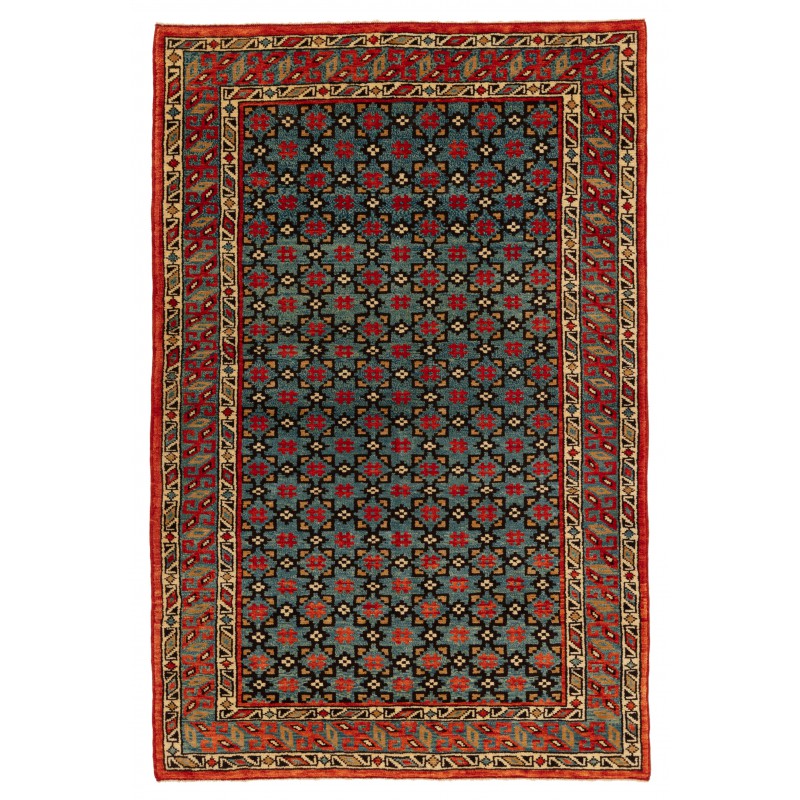
売り切れ
ディブリギ・ウル・モスクの絨毯 The Divrigi Ulu Mosque Carpet
214,000円
税込み: 214,000円
- Stock: 売り切れ
- Model: C50251
- サイズ: 157cm x 105cm
この絨毯は、書籍「13世紀から18世紀のトルコの絨毯」、アフメト・エルトゥール、1996年pl.16からのものです。この15世紀の絨毯は中央アナトリアのディブリギ・シヴァス地域にあるウル・モスクからのものです。セルジューク朝時代はアナトリアの美術と建築の最高峰の一つを記念するものであり、この時代のトルコ結び絨毯の2つのグループの発見によって非常に大きな興奮が引き起こされました。1905年、フレドリック・ロバート・マーティン(1868-1933)によってコンヤのアラエッディン・モスクで7つの例が見つかりました。アラエッディン・モスクは12世紀中ごろから13世紀中ごろにかけて段階的に建設された、スルタン国の中心にある主要なモスクです。一般的に「セルジューク」または「初期コンヤ」と呼ばれています(ただし、これらはコンヤに帰属される後の絨毯とは関係ありません)。これらはすぐに初期アナトリア絨毯の最も重要なグループと見なされるようになりました。そのパターンは建築に反映されず、セルジューク朝の宮廷の芸術を代表するものではありません。むしろ、この時期に中央アナトリアに住んでいた遊牧民または半遊牧民のトルクメン族の一つの作品と考えられています。したがって、「セルジューク朝時代」と呼ぶことがより正確でしょう。そのうち4つは大きくて不完全であり、他の3つは断片的な状態です。これらは1911年にイスタンブールのエヴカフ博物館に移され、その後トルコ・イスラム美術博物館に移されました。絨毯のデザインは、私たちのセルジュークタイプの絨毯コレクションからの解釈です。デザイナーたちによってフレームの連続と鮮やかな色が選ばれています。
The source of carpet comes from the book Turkish Carpets from the 13th – 18th centuries, Ahmet Ertuğ, 1996 pl.16. This 15th-century carpet is from Ulu Mosque, Divrigi Sivas region, central Anatolia. The Seljuk period marks one of the highest points in art and architecture in carpets Anatolia. It is therefore not surprising that tremendous excitement was caused by the discovery of two groups of Turkish knotted-pile carpets from this era. In 1905 seven examples were found by Fredrik Robert Martin (1868-1933) in the Ala’eddin Mosque in Konya, the foremost mosque at the heart of the Sultanate, which was constructed in stages between the mid-12th and mid-13th centuries. Generally referred to as the ‘Seljuk’ or ‘Early Konya’ carpets (although they do not relate to any later carpets that are attributed to Konya), these soon came to be considered the most important group of early Anatolian carpets. Their patterns are not reflected in the architecture and do not represent the art of the Seljuk court; they are more likely the work of one of the nomadic or semi-nomadic Turkmen tribes that inhabited central Anatolia at this time. Labeling them ‘Seljuk-period’ would therefore be more accurate. Four are large but incomplete, the other three are fragmented. They were transferred to the Evkaf Museum in Istanbul in 1911, and then to the Museum of Turkish and Islamic Arts. The design of the carpet is interpreted by our designers from our Seljuk-type carpets collection with a series of borders and vivid colors are chosen by our designers.
全部で6色使っています。主な4色は以下です。
- Dark Brawn 316 (羊そのままの色)
- Cadet Blue 26 (トウダイグサ - 藍)
- Imperial Red 426 (茜)
- Natural Wool Color 320 (羊そのままの色)
上の番号は私たちのカラーコードです。()の中は、主な草木染めの材料です。
